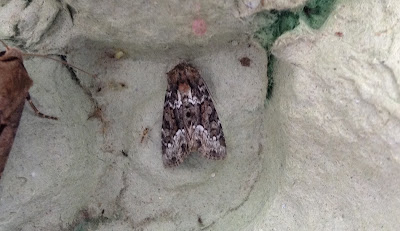 The moth trap works on the same principal as a lobster pot or crayfish trap, with a funnel tapering inwards to its narrower end to admit the insects whose sense of direction has been disorientated by the powerful light. (Or so we think; the question of attraction and distraction is not yet fully resolved in spite of the great age of the saying 'like a moth to a flame').
The moth trap works on the same principal as a lobster pot or crayfish trap, with a funnel tapering inwards to its narrower end to admit the insects whose sense of direction has been disorientated by the powerful light. (Or so we think; the question of attraction and distraction is not yet fully resolved in spite of the great age of the saying 'like a moth to a flame').
Appropriately therefore, I caught a lobster yesterday morning - the fine moths shown below with its distinctive way of resting with its underwing petticoats peeping out on either side.
 Its grey is a little like an uncooked lobster's with that added flush of pink which might hint at the joys of a seafood dinner. But there the resemblance ends. Not so when it comes to the caterpillar, shown right. What an amazing feat of 'Keep Off!' camouflage - or whatever the opposite of camouflage is called, when the protection lies in the obvious but dangerous-looking and and unappetising appearance.
Its grey is a little like an uncooked lobster's with that added flush of pink which might hint at the joys of a seafood dinner. But there the resemblance ends. Not so when it comes to the caterpillar, shown right. What an amazing feat of 'Keep Off!' camouflage - or whatever the opposite of camouflage is called, when the protection lies in the obvious but dangerous-looking and and unappetising appearance.
A little greenery now: first a Green Oak Tortrix turning its tiny back on a Straw Dot, both pygmies but the first a micro and the second a macro, thanks to the arcane joys of moth classification.
 And next what I am pretty sure is a Green Pug because of the delicate greenish shade, though pugs are notoriously alike and difficult to distinguish, for me at least. You may be amused to see what came up when I put 'green pug' into Goggle Images. Something to do with St Patrick's Day in the world of small dogs, apparently.
And next what I am pretty sure is a Green Pug because of the delicate greenish shade, though pugs are notoriously alike and difficult to distinguish, for me at least. You may be amused to see what came up when I put 'green pug' into Goggle Images. Something to do with St Patrick's Day in the world of small dogs, apparently.
I also have the chance, courtesy of Wednesday's visitors, to show you the effects of age on moths - probably a difference only of a week or two but the top picture, below, shows a pretty freshly-hatched Marbled Minor. The second is of an older and somewhat careworn relative.
Finally, two favourites: the Buff Arches with its triangular resting habit very similar to that used by the Burnished Brass, plus the Arabic-looking squiggles on its wings - doubtless an example of confusion camouflage like the dazzle used on wartime ships. And the final picture shows a delicate Riband Wave, a moth which comes in two equally attractive forms; this one and a version where the space between the double lines is smoky beige.










No comments:
Post a Comment